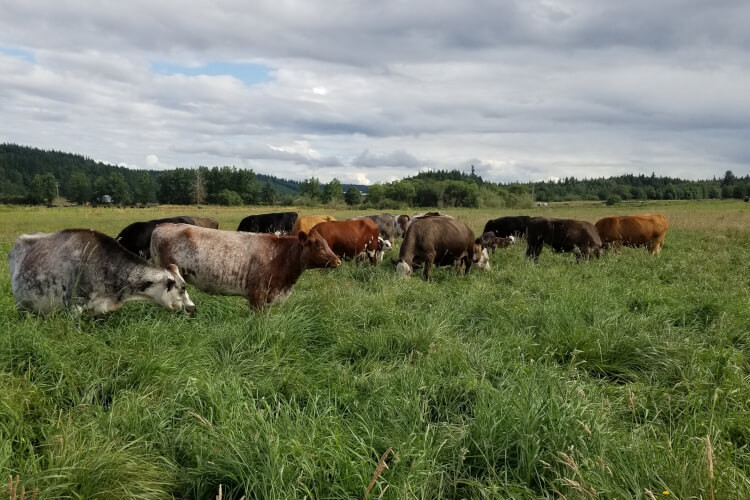Cattle Drive – One Straw Ranch Style! [Video]
posted on
July 12, 2022

What do you think of when you think of a cattle drive? Horses, dust, rustlers, cowboy hats, John Wayne…
Me, too!
So I got a good laugh at myself when I wanted to share this week’s video with you and had to come up with a title for it.
Spoiler Alert! At One Straw Ranch we don’t have horses, dust, rustlers, or John Wayne.
But despite the lack of appropriate cowboy paraphernalia, we do have cattle drives. And not just once or twice a year, but all the time!
In all the Old Western movies, and on many ranches today, cows are only moved sporadically. For instance, to get them out to Spring pasture, back to the home ranch for the Winter, or when sending them off to the stockyards and harvest.
But not at One Straw. Spring through late fall, when the grass is growing, our cows typically move several times a week.
This means lots more fencing and lots more time-intensive management.
The grass volume has to be monitored and matched to the cows’ consumption, the portable electric fencing has to be moved, multiple water points must be managed, and then when all’s in order the cows themselves must be moved.
But all that time with feet on the ground, eyes on the animals, and brain cells making grass-y calculations is what creates the delicious flavor and high quality of One Straw beef!
But in a beautiful, natural symbiosis, all that management also creates amazing ecological outcomes!
I’m getting into the weeds a bit here (and when talking mixed pasture I mean that quite literally, hehe), but it can’t be said too many times that regeneratively managed cattle create not only excellent beef but also improve soil health, which makes for happy microbes, which results in more grass growth, which sequesters more carbon, which improves the water cycle - all while creating habitat for chirping birds, buzzing pollinators, and a whole host of the small lives that sustain ours in unseen ways.
Talk about a scenic outlook!

Sit still in one of our pastures and you quickly become overawed at the multitude of lives surrounding you.
So today we share a brief glimpse of that tranquility and inter-connectedness. Turn on your volume to hear the cattle conversing with Martin and the birds and insects all atwitter.
[Click here to watch the video.]
An entertaining part of the frequent moves is that the cattle know the routine as much as we do.
And it helps that they like the routine – our cows actually get to eat the grass on the other side of the fence – which makes it easy on everyone.
Though sometimes think they know better than we do just exactly what should be happening.
Notice at the beginning of the video how all the girls were standing at the fence, waiting to move.
That means that they had gauged (correctly) that they’d eaten the appropriate amount of grass in the previous paddock.
Therefore, when they heard us arrive, they lined up for the move.
If there was still a lot of grass in their paddock and they didn’t feel like moving, they would have been laying about in the field, relaxing for their mid-day siesta, when we came to check on them.
In that instance only lots of calling and cajoling would encourage them to get up and move, and they would have shared lots of complaints and grieved looks as they complied!
Hmmm. It’s kind of like having three and five year old Farmhands…
Anyway, sit back and enjoy a One Straw cattle drive. You can put on your cowboy hat, if you wish :)




